Irori – The Japanese Hearth
Now that winter is coming and the weather forecast showed the symbol for snow here in Tokyo it might be interesting to talk about heating. This is the season where many foreigners (and indeed many Japanese) wonder aloud how Japanese homes can be so fantastically cold. The discussion usually involves plenty of curse words unfit for reproducing on a family blog like this! Foreigners usually wonder why Japanese homes aren’t better insulated. In northern Japan, including all of Hokkaido and large parts of the northernmost prefectures, insulated western style homes, complete with double or triple glazing, is the norm. In the rest of Japan you will very rarely find insulation in homes. One of the reasons for this is that insulation is basically for heated homes, and Japanese homes generally aren’t heated. While westerners use huge amounts of resources to ensure they have comfy homes at a perpetual 20 degrees no matter the season, Japanese are used to the old idea of heating only the people inside the house, although this is changing and more and more people heat their homes.
I remember some mornings in my first home in Tokyo, a rickety old three story wooden framed stick building where it was so cold that I found ice on the glass of water left beside my bed. The common feature in almost all Japanese homes is the kotatsu, a low table covered in a thick skirt and heated underneath, trapping all the heat inside and keeping the entire family gathered around it with their lower bodies comfy and warm and all bundled up in warm clothes on their upper bodies. This is such a universal feature in Japanese life that countless Japanese customs can be explained by observing how a family use their kotatsu in winter. Almost every family you talk to will have similar stories of refusing to leave the kotatsu and taking turns to get up for errands like changing the channel on the TV or getting mikan fruit from the kitchen. You will also get stories of whole families sleeping around the kotatsu rather than going up to their freezing bedrooms. There is even plenty of room for romance and fun around the kotatsu, for young and old couples. Any Japanese book, manga, anime or TV show depicting family life will have these kotatsu-scenes.
But before the kotatsu there was the irori, the Japanese hearth. It is a sunken hearth in the middle of the traditional Japanese living room, filled with fine sand and ashes. Contrary to common sense it is always made of wood, the sand protecting the fire-hardy pear tree heartwood from burning. It might seem counter-intuitive, but the Japanese have managed to invent a way to keep an open fire in a wooden fire pit inside a wooden house with paper doors and straw mat floors, in an ecological, economical and healthy way! The irori has many uses. It heats the room, it provides a spot to grill, cook or bake simple food. You can heat or boil water. It lights the room and keeps the fire alive throughout the night which was handy before matches or lighters. It dries clothes. It gathers the family and helps communication. It shows family hierarchy and provides a simple symbol of stability. It dries the timbers of the house, preventing rot, fungus and wood disease, preserving the house for hundreds of years (there is even one wooden house that has been continuously inhabited for over 1000 years).
In the old days when the smoke of the indoor fire was important for preserving the thatched roof of all homes, it was common to use both firewood and coal, but as people get more prosperous they prefer the smoke-less coal. In the old days people were free to pick fallen branches and harvest fallen logs but were not allowed to cut living wood, so it was easy to gather enough fuel for the irori. Making coal however was an extra step in the process and although an easy and simple job it was not possible for many families to gather enough wood or bamboo to make coal.
To stop sparks many irori had a woven mat hung over them, which could be used to dry fish, forage and fruit for preservation, but the classical irori always had a jizakagi, a hollow bamboo pole suspended from the ceiling containing a metal rod or chain, with a hook at the end. The jizaikagi is the most important tool in using the irori. It has a lever that is usually in the form of a fish, that allows you safely regulate the hight of the hook and how close your food or pot is to the fire.
Why the fish form? There are two often recited reasons for this. The fish being a water creature, is symbolically protecting against the fire of the hearth, thus preventing accidents and house fires. The other reason is related to the first, in that fish having no eyelids were thought to never sleep, which is a good ability to have if you are guarding a fire.
This irori and the old men volunteering to tending the fire is inside a beautiful old house at the Edo-Tokyo Open Air Architectural Museum (江戸東京たてもの園), in Koganei, western Tokyo. The last photo is of the inside of the house, very thin walls and absolutely no insulation even in the middle of winter.
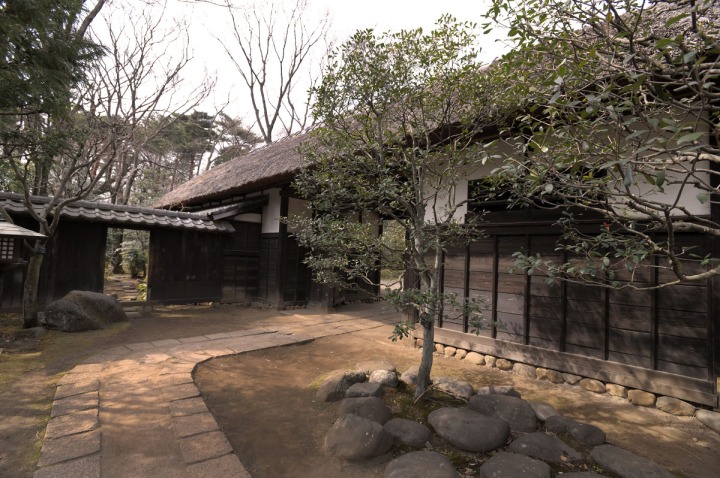
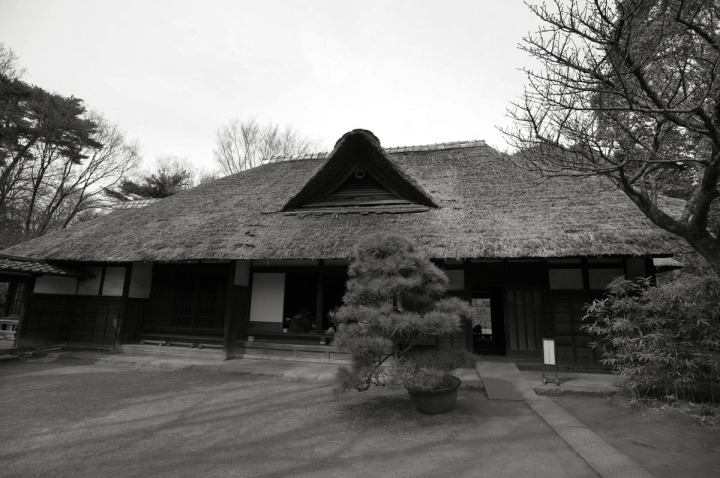
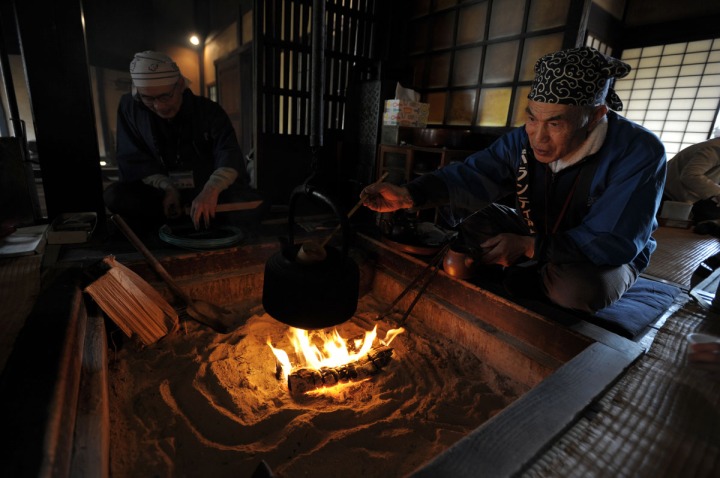

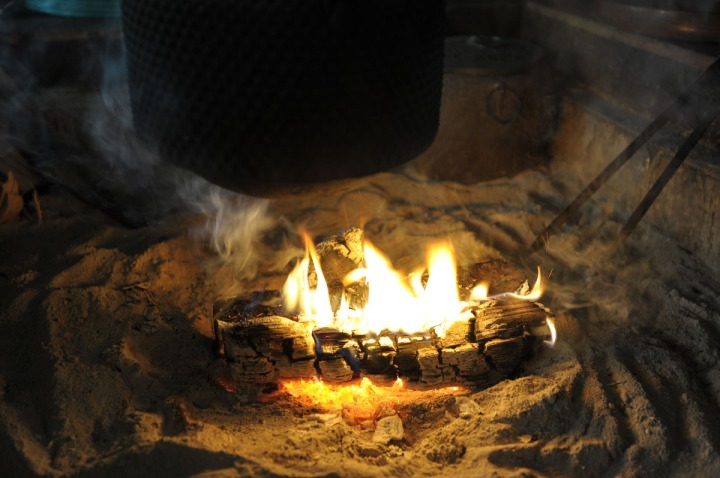
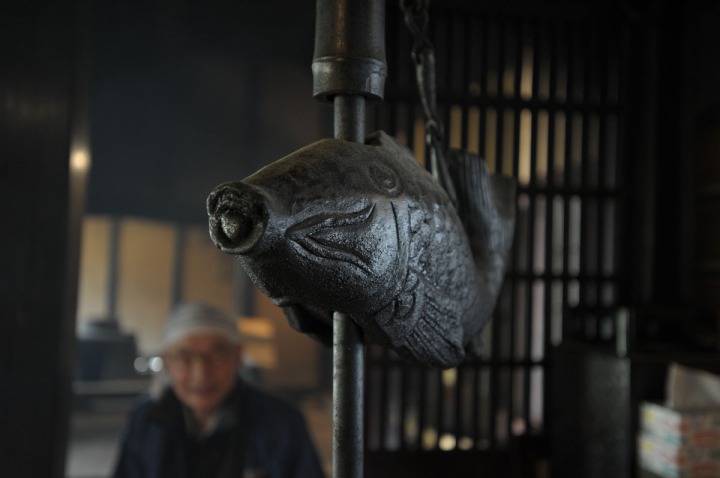
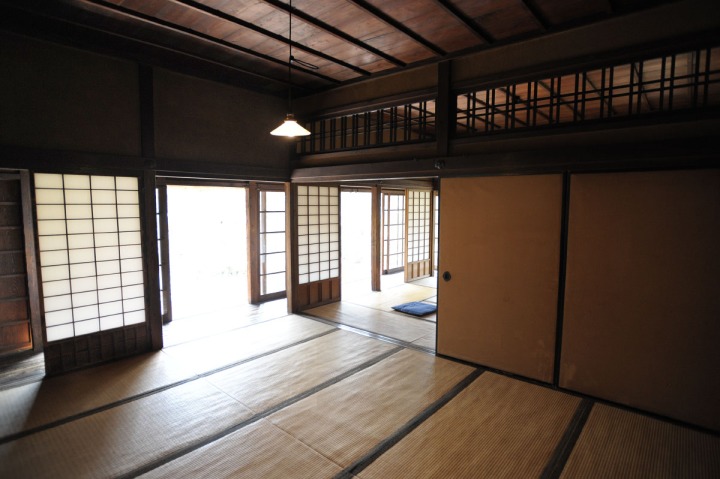
When my daughter was working as a JETT in a rural part of Japan, she was assigned to live in an old farmhouse with a tatami mat floor, paper shoji doors, and no heating fixtures except for an electric heater that was set underneath a table with the kotatsu spread over it. She said that in the mornings, she could see her breath when she woke up, and as you experienced, she also saw ice form in any standing water she and her housemate left overnight in the house. The house down the road from hers was exactly like this, except it was occupied by an older couple in their 80s. She couldn’t believe old people could tolerate such brutally cold weather, though it seemed to make them very energetic, to the point they were always complaining to her and the school she worked at that she and her housemate didn’t clear the snow off of their driveway and section of the road quick enough! 🙂
LikeLike
Hahaha… what a great experience she must have had! I totally agree with the old couple. Not moving is not an option when it is that cold, you have to be energetic to stay alive! And think of all the exercise that couple must be getting. I would love to live in an old house like that. Unfortunately now my house is just cold, but without the accompanying exercise and fitness!
LikeLike
Wonderful post. In particular like the atmosphere of accompanying photographs. I didn’t know Japanese homes were unheated.
LikeLike
Thank you Allen! I appreciate your kind comment. Traditionally Japanese homes were unheated and uninsulated, at least south of Hokkaido. However, most newer buildings (after the 1990’s) are at least insulated and more and more houses have different kind of heating systems these days. However, hospitals, offices and modern workplaces are heated, as are some of the more modern schools. But I still often visit workshops, factories and community spaces that are completely unheated. I have also never lived in a heated or well insulated home. (^-^)
LikeLike
This rang so many bells. We were in Tokyo for 3 weeks last December and I have never been so cold inside in my life! I thought we’d picked a bad apartment but apparently it’s the norm! I do admire the toughness of the Japanese, not heating their homes like we do. But I’m glad I live in the USA 🙂
LikeLike
The inari looks very cozy and the guy in #4 looks badass, although I don’t get the family hierarchy thing: the older you are, the closer you are to the heat source? 🙂
I think unheated houses were fine during a time period when people moved all day for work. I know when I come home to a “cold” place after hiking all day, I don’t feel cold. Nowadays everyone is chained to their desks and the commute is generally seated as well. Not moving around = feeling colder. I will freely admit to being a wimp in this case!
LikeLike
This is a very good well detailed post.
When I was small, our house had a Kotatsu and the relatives’ house in the country side
was looked like this in the photo. Hence I’ve seen a Irori and remembered to eat a Rice-cake
baked near the fire. In 60s, many of the old style hoses were changed to the semi-western style
and started to have Kerosene-stove then Gas-stove.
LikeLike
Hierarchy is kept in its position. Nobody sit behind of others. (Have to show the face.)
The furtherest place from the entrance is Kami-za / Oku where it was reserved to the most senior,
and a person sitting nearest to the entrance has to move around such as to fetch the water, hence
it called Shimo-za. This order is kept the same, if it was to sit on a Tatami in a Japanese restaurant.
LikeLike
This sounds like the England of my youth – nostalgic and appealing as well as uncomfortable!
LikeLike
Haha… I was waiting for someone to make the comparison! Some of my coldest experiences ever have been in English and Scottish homes: waking up in the middle of the night due to the cold… (^-^;) People were tougher back then!
LikeLike
I was just in Edinburgh as part of my RTW trip and had almost forgotten about that little inconvenience! Brr in those tenement homes, and newer construction is just as bad. Good thing I was taking care of a Maine Coon who insisted on sleeping on my feet…
LikeLike
That`s totally true. When we came here I was constantly turning up the heater until the inside the temperature got around 20 degrees. Now, after two year, I am comfortable only with 17. In the morning when we wake up it is around 14.
LikeLike
You get used to everything – and anything that is ecologically better gets my stamp of approval! (^-^)
LikeLike
Interesting article! By the way, I think you mean “charcoal” not “coal”. Charcoal is made from wood, while coal is rock dug out of the ground.
LikeLike
Thanks! Yes, you are probably right. I have heard stories of people using rock coal for their home hearths, but probably not through choice. Charcoal is more likely!
LikeLike
How are these vented to the outside?
LikeLike
They are not specially vented. The smoke rises and goes through the thatched roof, keeping the roof dry, sterile, driving away insects and killing fungus. You can not have a functioning irori without a thatched roof, and you can not have a functioning thatched roof without irori.
LikeLike